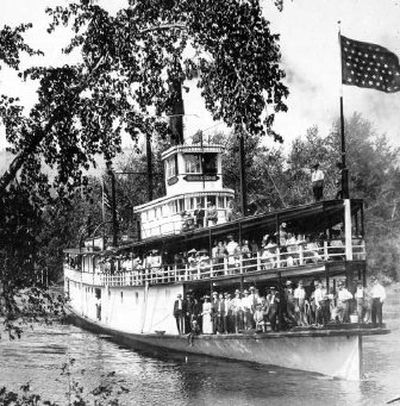Travel by water

Today, freeways are America’s preferred travel method, but it wasn’t too long ago that the cost of gas didn’t even factor into weekend plans.
From 1880 through the 1920s, steamboats reigned supreme on North Idaho’s waters. Though the first steamboat on Lake Coeur d’Alene was built for the military, others were quickly built for commercial and pleasure purposes. The lake rapidly became the steamboat capitol of the west; its roughly 50 steamboats were more than any other lake west of the Great Lakes.
In 1880, soldiers at Fort Coeur d’Alene (later known as Fort Sherman) faced transportation problems. They had fixed the old Mullan Road, but carrying supplies with wagons and mules was slow and expensive. If local Indian tribes revolted, the military would need a quick way to move troops.
The base commander hired Norwegian Peter Sorensen to build the 85-foot steamboat Amelia Wheaton. Construction did not go smoothly. “There are some documents in a newspaper that was put out by the fort,” said Robert Singletary, president of the North Idaho Museum, which showed that “the soldiers were really rebelling earning higher pay.”
Sorensen became the boat’s captain, since no one else in the military knew how to pilot a steamboat. At first it hauled hay from the southern part of the St. Joe River to the fort for the horses, but after gold was discovered in 1881 and silver in 1884, miners bought passage. Sailing down the lake, up the river to the Cataldo Mission, and over to their camps was both faster and cheaper than the Mullan Road.
Sorensen built several private boats to haul the ore, but the mines faced another problem.
“There was no processing facility in the area,” said Singletary. “The nearest processing facility was in Montana … owned by a guy named Sam Hauser.”
Hauser and businessman D.C. Corbin devised a system of trains and steamboats to take the ore from docks at what is today’s Third Street to the Montana smelter, and hired Sorensen to build their boats. In 1889, Sorensen hired a young assistant, Peter Johnson.
“Sorensen called himself Norwegian One and Johnson Norwegian Two,” said Singletary. After Sorensen retired, Johnson continued to seek his advice. The two men alone built more than half the lake’s steamboats.
Anything needed at the Cataldo Mission or in towns like St. Maries and St. Joe City was hauled by steamboat: food, saloon supplies, horses, workers and more.
By 1890, railroads had replaced steamboats as the primary way to haul ore, but the boats soon gained two new uses: hauling supplies to lumber camps and feeding the new tourist industry. Singletary said that as the boats carried timber supplies, “St. Joe became a major, major steamboat route, and little communities began to grow.”
Businessmen Frederick Blackwell (who also built the city park) and J.C. White (who lived in Sherman Avenue’s White House) built an electric railroad from Spokane to Coeur d’Alene, which ran several times a day. Tourists would come on the train to ride the steamboats, some of which were 125-feet long and held 1,000 passengers. The Georgie Oakes became known for her fine dining, and tourists would often ride a boat to one of the fancy St. Joe River hotels to spend the night.
The boats were mostly owned by two rival companies, White’s Red Collar Line and E.D. McDonald’s White Star Navigation. Competition between the two was fierce. At one point, White’s 147-foot Idaho rammed into McDonald’s smaller Boneta. The Idaho captain claimed he had his signals confused, but on another occasion, White and McDonald almost came to blows.
“It became a very petty, very vicious competition between those steamboat lines,” said Singletary. Eventually, White’s Red Collar Line won out.
Part of the boats’ attraction were their crews. Singletary occasionally gives lectures on steamboat history aboard Heyburn State Park’s boat Idaho, and incorporates “living history performances” into his presentations. In September, he will unveil his latest character. “(Ian) Lliard was a captain during the ‘20s and ‘30s,” he said, “and was quite a storyteller, quite a colorful guy.” The captain was a respected hunter, claiming to have killed more than 200 cougars. His passengers were never fully sure if his stories were true or not.
As the automobile gained popularity, the steamboats fell out of favor.
“The old steamboats that used to be queens of the lake just rolled over and rotted on the bank someplace, or they were torn apart,” said Singletary. The most famous of the boats, the Flyer, was set ablaze as part of the 1938 Fourth of July celebration, ending an era.
Although none of the old steamboats exist today, the North Idaho Museum does have a number of salvaged lanterns, steering gears, bells, and other artifacts. Many of the Hagadone Corp.’s cruise ships are named after the old steamboats, and Singletary hopes to one day see a replica of an old boat in the museum.
He adds that it’s important for us to remember the steamboat heritage. “If you go back and take a look at how many of our stories and books and songs are written about steamboats and railroads, it’s just amazing.”